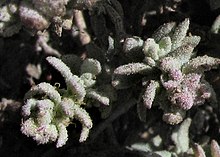Atripliceae
Appearance
| Atripliceae | |
|---|---|

| |
| Extriplex californica | |
| Scientific classification | |
| Kingdom: | Plantae |
| Clade: | Tracheophytes |
| Clade: | Angiosperms |
| Clade: | Eudicots |
| Order: | Caryophyllales |
| Family: | Amaranthaceae |
| Subfamily: | Chenopodioideae |
| Tribe: | Atripliceae |
| Genera[1] | |
| |
Atripliceae are a tribe of the subfamily Chenopodioideae belonging to the plant family Amaranthaceae. Atriplex is the largest genus of the tribe. Species of Atripiceae are ecologically important in steppe and semi-desert climates.[2]
Distribution
[edit]Most of the species are distributed in Africa, Australia, and North America, with some others spread out worldwide.[3]
Taxonomy
[edit]Traditional taxonomy of Atripliceae based on morphological features has been controversial.[2][3] Molecular studies have found that many genera are not true clades. One such study found that Atripliceae could be divided into two main clades, Archiatriplex, with a few, scattered species, and the larger Atriplex clade, which is highly diverse and found around the world.[3]
References
[edit]Wikispecies has information related to Atripliceae.
- ^ Fuentes-Bazan, Susy; Uotila, Pertti; Borsch, Thomas (2012). "A novel phylogeny-based generic classification for Chenopodium sensu lato, and a tribal rearrangement of Chenopodioideae (Chenopodiaceae)". Willdenowia. 42 (1): 5–24. doi:10.3372/wi.42.42101. ISSN 0511-9618.
- ^ a b "Molecular phylogeny of Atripliceae (Chenopodioideae, Chenopodiaceae): Implications for systematics, biogeography, flower and fruit evolution, and the origin of C4 photosynthesis". www.pubfacts.com. Retrieved 2015-12-30.
- ^ a b c Flores, Hilda; Davis, Jerrold I. (2001). "A Cladistic Analysis of Atripliceae (Chenopodiaceae) Based on Morphological Data". Journal of the Torrey Botanical Society. 128 (3): 297. doi:10.2307/3088719. JSTOR 3088719.
